Menus
- The dream from old times
- The original version of the Egli-Kawasaki MRD 1 weighed 210 kg with a full tank
- The compressor wheel builds up boost pressure from 4000 rpm
- Comfortable and touristy despite the soft suspension setup
- Brief portrait of Fritz W. Egli
- 1 BILLION in MOTORRAD Revue 1979
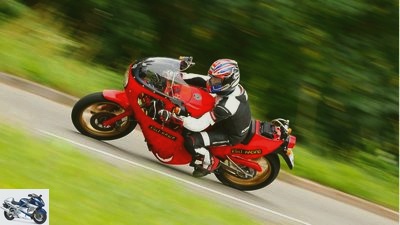
Gargolov
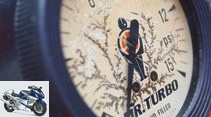
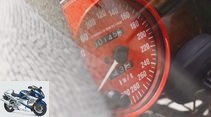
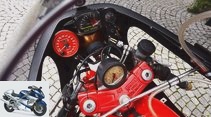
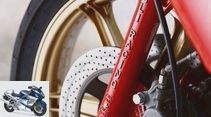
34 photos

Gargolov
1/34
The sensation in the MOTORRAD Revue 1979: The original version of the MRD1 had a Kawasaki Z 900 drive that had been drilled out and tuned to 1016 cubic meters and produced 140 HP on the rear wheel and 155 HP on the crankshaft.
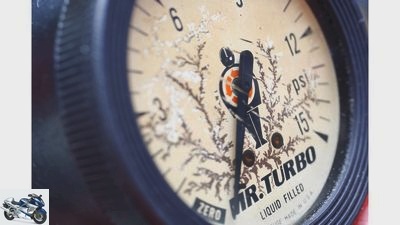
Gargolov
2/34
Egli-Kawasaki MRD 1 in the driving report.
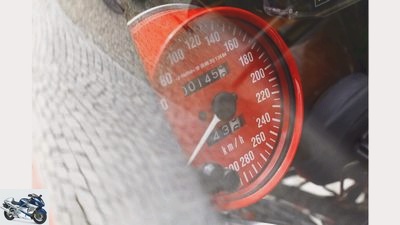
Gargolov
3/34
The speedometer of the Egli-Kawasaki MRD 1.

Gargolov
4/34
The cockpit of the Egli-Kawasaki MRD 1.

Gargolov
5/34
Egli-Kawasaki MRD 1 in the driving report.
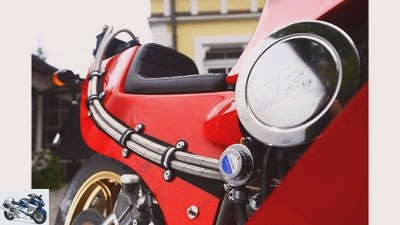
Gargolov
6/34
Egli-Kawasaki MRD 1 in the driving report.
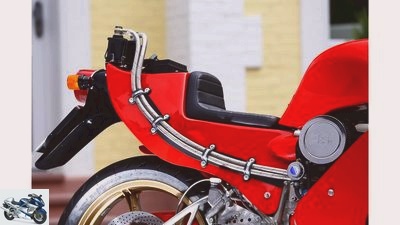
Gargolov
7/34
Egli-Kawasaki MRD 1 in the driving report.
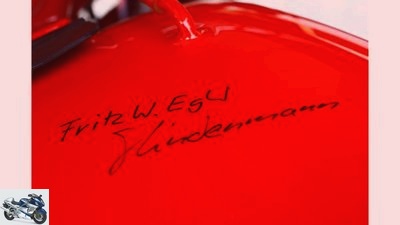
Gargolov
8/34
Egli-Kawasaki MRD 1 in the driving report.
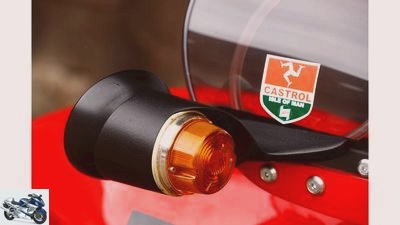
Gargolov
9/34
Egli-Kawasaki MRD 1 in the driving report.
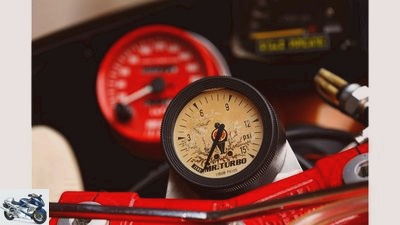
Gargolov
10/34
Egli-Kawasaki MRD 1 in the driving report.
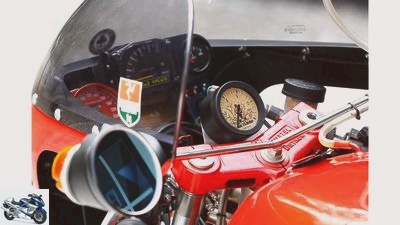
Gargolov
11/34
Egli-Kawasaki MRD 1 in the driving report.
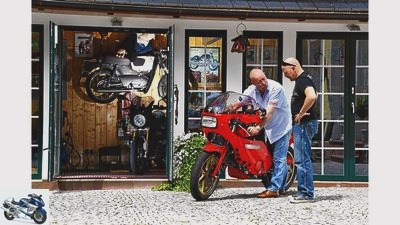
Gargolov
12/34
Horst Lichter to Rolf Henniges: “The MRD1 will surprise you – you sit relatively comfortably”.
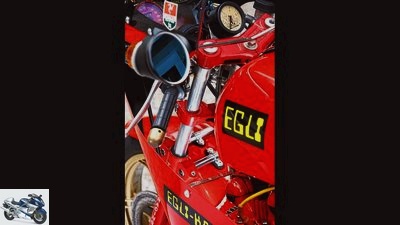
Gargolov
13/34
Better safe than sorry: two massive bridges, a powerful fork stabilizer plus 36 mm stanchions guide the front wheel.
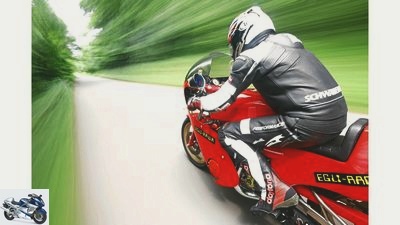
Gargolov
14/34
One in five. 32 years old. 55,000 euros expensive. 220 hp, 160 mm slippers, 300 km / h. Heart rate 200. What a day!
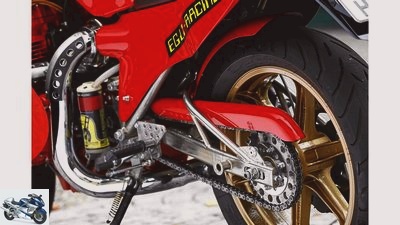
Gargolov
15/34
Rear wheel guidance through a cantilever swing arm made of specially alloyed steel – handcrafted.
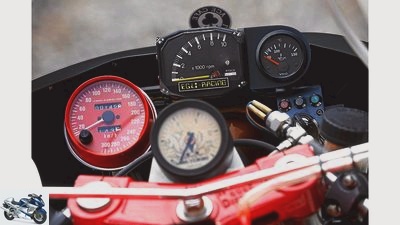
Gargolov
16/34
More important than revs or speed: the turbo boost display in the foreground. The boost pressure can be adjusted manually.
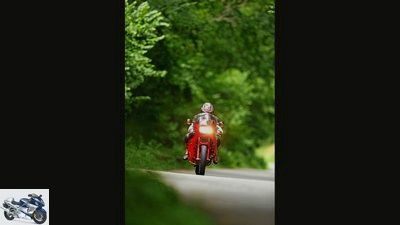
Gargolov
17/34
The holes in the panel have nothing to do with Swiss cheese. They enable cooling.
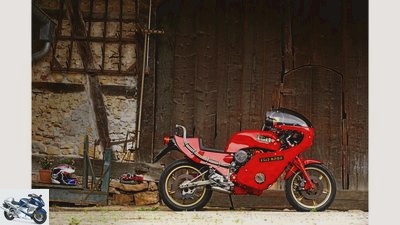
Gargolov
18/34
Still life: Even over thirty years after its production, the MRD1 has lost none of its visual appeal and cuts a fine figure everywhere.
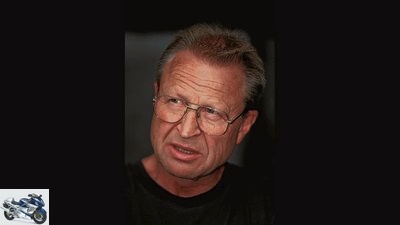
Gargolov
19/34
Fritz W. Egli himself says that he is a perfectionist, autodidact, pedant and racing driver.

Gargolov
20/34
Red is love. Hence the painted engine. An elaborately designed four-in-one manifold chases the exhaust gases into the turbocharger. The housing vent and carburetor overflow flow into the oil bottle.
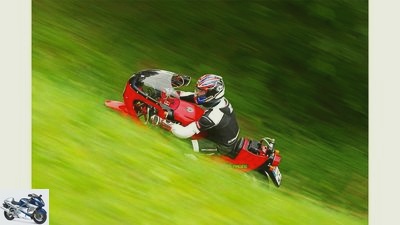
Gargolov
21/34
In total, only five copies were made in Fritz W. Egli’s workshop. But he also sold some rolling chassis from the MRD1. The machine driven here is one of the five. It dates from 1982, has 1200 cc and 220 hp.
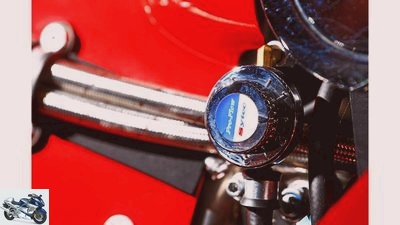
Gargolov
22/34
The delivery rate of the additionally installed fuel pump can be regulated with a hand wheel.
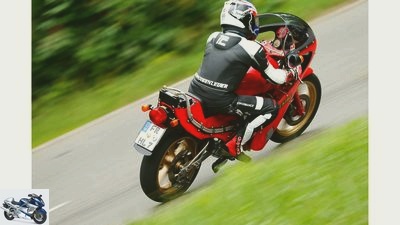
Gargolov
23/34
Egli-Kawasaki MRD 1 in the driving report.

Gargolov
24/34
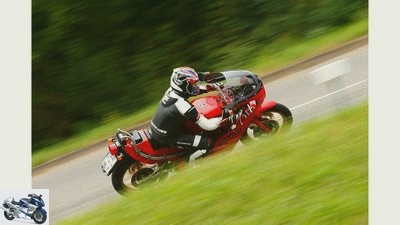
Gargolov
25/34
Egli-Kawasaki MRD 1 in the driving report.
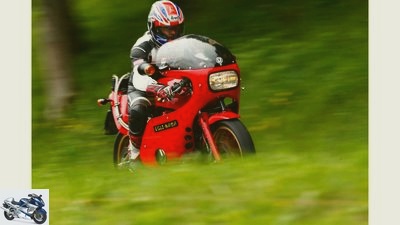
Gargolov
26/34
Egli-Kawasaki MRD 1 in the driving report.
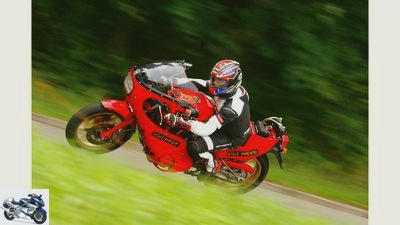
Gargolov
27/34
Egli-Kawasaki MRD 1 in the driving report.
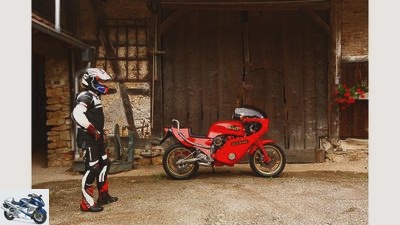
Gargolov
28/34
Egli-Kawasaki MRD 1 in the driving report.
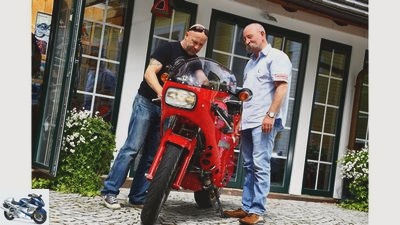
Gargolov
29/34
Horst Lichter and MOTORRAD editor Rolf Henniges examine the legendary bike.
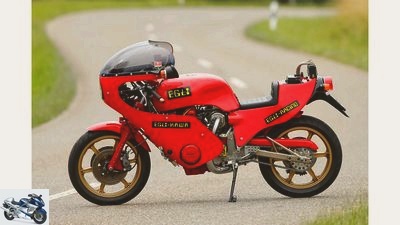
Gargolov
30/34
Egli-Kawasaki MRD 1 in the driving report.
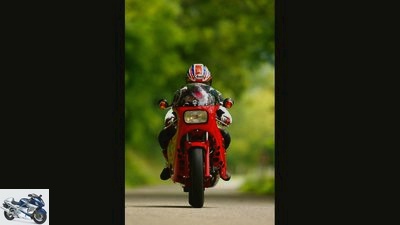
Gargolov
31/34
Egli-Kawasaki MRD 1 in the driving report.
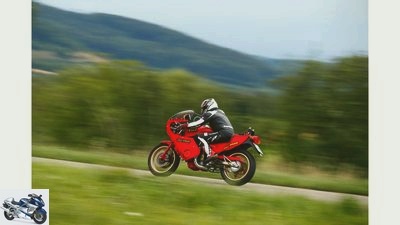
Gargolov
32/34
Egli-Kawasaki MRD 1 in the driving report.
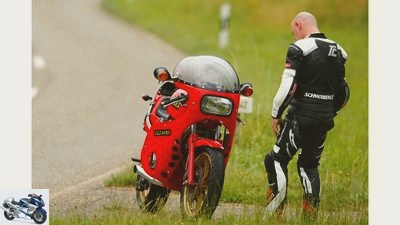
Gargolov
33/34
Egli-Kawasaki MRD 1 in the driving report.
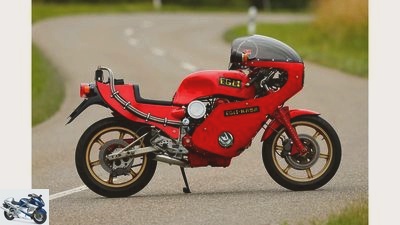
Gargolov
34/34
Egli-Kawasaki MRD 1 in the driving report.
Egli-Kawasaki MRD 1 in the driving report
The dream from old times
MOTORRAD drove it – the Egli-Kawasaki MRD 1. One of five. 32 years old. 55,000 euros expensive. 220 hp, 160 mm slippers, 300 km / h. Heart rate 200. What a day!
The best thing about the Egli-Kawasaki M.RD 1 is their complete history: built in 1982 on behalf of a customer with 1200 cubic meters, then sold. The second owner wrecked the engine and sold the machine again. The third owner brought it to Egli for rebuilding in Switzerland, but ultimately couldn’t pay for the work, and so the MRD1 stood there for 24 years and was actually just waiting for me, ”says its current owner, twirling the opulent one Schnauzer. Something he does all the time. Because the beard belongs to the famous TV chef Horst Lichter.
Buy complete article
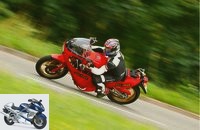
Egli-Kawasaki MRD 1 in the driving report
The dream from old times
Egli built between 1979 and 1982. How much does it cost? “Nothing goes below 50,000 euros,” says Horst irrelevantly. It sounds like a friendship award. But he doesn’t want to sell the Egli-Kawasaki MRD 1.
The original version of the Egli-Kawasaki MRD 1 weighed 210 kg with a full tank
I’m prepared, I’ve read the old reports about the Egli-Kawasaki MRD 1: In 1978 – I was just 13 years old – MOTORRAD commissioned the Swiss tuner Fritz W. Egli to build an absolutely uncompromising motorcycle. Requirements: as much power as possible, the most stable chassis possible. Egli picked up the Kawasaki Z 900 engine, prescribed a turbocharger and planted the drive in its proven central tubular frame with cantilever swing arm. What sounds mundane 35 years ago was associated with a murderous expense. It was ultimately worth it: the original version of the MRD1 weighed 210 kg with a full tank, and the Swiss test bench certified its engine with 155 hp on the crankshaft. And the trade press was jubilant: “Here, a power-to-weight ratio of 1.354 kilograms per PS is calculated, a value that comes close to that of a Formula 1 racer.”
It left me cold. At least when reading the reports on the journey to Horst Lichters domicile. Because: Even the first Yamaha YZF-R1 achieved a similar power-to-weight ratio in 1998 without any turbo fuss. Not to mention what is on offer today: I just say BMW S 1000 RR – 199 kg with a full tank, measured 203 hp! We are currently at a power-to-weight ratio of less than one kilo per hp. And? Already driven, of course! But when Horst pushes the object of desire out of the garage, my arrogant composure suddenly gives way to a queasy feeling. This motorcycle is not just any motorcycle. Worldwide admiration was given to it, hundreds of thousands had it hanging as a large poster in the workshop or over the bed. The Egli-Kawasaki MRD 1 was a dream. Back then, in the late 1970s. And it still is today. It starts with the color, that bright red that stands for love and blood, and ends with the terrifying, huge turbocharger that supposedly breathed 220 hp into this specimen here from 1982 on the test bench.

classic
Egli-Honda and Seeley-Honda
Who survives whom here?
read more
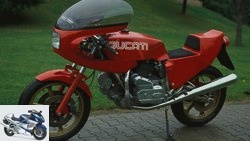
classic
Cult bike Egli-Ducati 900 SS
Cult meets cult
read more
Gargolov
Still life: Even over thirty years after its production, the MRD1 has lost none of its visual appeal and cuts a fine figure everywhere.
“The tank is full,” says Horst and pats me on the shoulder. “And you are well insured. So get in, my dear! ”Get in? I feel like going to the toilet. Scared shit. The motorcycle is extremely expensive, its owner is an ultra-prominent television star, and the chassis failed the stress test. Honestly: If you press down a current sports motorcycle while standing, it springs in and out again with a smooth, damping effect. The spring elements of this Egli-Kawasaki MRD 1, however, behave like springs with almost no damping. “You’ll see”, grins Horst, “you don’t sit too badly.” Aha. Right. At least in terms of the seat height, which is comfortably low at 770 millimeters. At the push of a button, the four-cylinder, bored out to 1200 cc, wakes up and warms up at 2000 rpm. The moment I click into first gear, two things go through my head: First, Horst explained to me that the turbocharger’s boost pressure was not set to maximum output. Second, the delivery rate of the additionally installed petrol pump may have to be adapted to the power input. Whatever that means, I’ll find out.
Ten tentatively driven kilometers later: So far I have not turned the engine above 6000 rpm. The turbocharger allegedly kicks in between 6500 and 7000 tours and ensures – as it was in all reports – over 50 meters long black lines on the asphalt. In general, the 1200 is quite comfortable to drive. It doesn’t vibrate unpleasantly, the transmission shifts precisely and easily, and the clutch, which is supposedly equipped with stronger springs, is wonderfully easy to operate. You only have to get used to the sitting position: the footrests high, the seat low, the legs strongly bent, the torso badly bent. Honestly: The Egli-Kawasaki MRD 1 is really not recommended for people with hip problems. The engine should gradually be warm despite the powerful oil cooler and huge oil volume, I think as this wonderful long straight in front of the front wheel unrolls …
The compressor wheel builds up boost pressure from 4000 rpm
Take a deep breath and draw in the gas. While the tachometer needle fights its way forward, lines from the MOTORRAD Revue whiz through my head: From 4000 rpm the compressor wheel builds up boost pressure. The paddle wheels in the turbo rotate at a maximum of 120,000 revolutions per minute. On the inlet side, air is pressed into the cylinders of the Egli-Kawasaki MRD 1 via an intake bridge. The boost pressure can be varied via a manually adjustable valve. Values between 0.1 and 0.9 bar are quite normal. And if there is more, the engine threatens to burst, the excess pressure escapes through a valve to the outside. But what exactly does that mean? 0.1 bar – the Puffi tuning with 150 hp and 0.9 bar the professional mode with 220 hp? Window paste! Stop now and take a quick look is not possible, the engine is turning so fast. I’m totally tense, but nothing happens. Not a black line. No rising front wheel. The arms are also not drawn out or the head pressed backwards. On the contrary, at 7500 rpm the box starts to stutter. I’m disappointed.
But also happy. My heart rate drops suddenly from 200 to 140. Although the machine steers itself incredibly easily and precisely thanks to the tires in the size of a cutting disc, I somehow don’t want to know whether and how the 36 fork and the soft suspension set-up work with almost 300 km / h tolerated. Allegedly at that time a top speed of 297 km / h and an acceleration from zero to 100 km / h in just 2.4 seconds were measured. Allegedly. Get off, go around MRD1. Aha, there was something else: the adjustable fuel pump is set to delivery rate one. Let’s just set it to four. A lot of air also needs a lot of gasoline, otherwise the mixture is not right. Reloading. And really: the Egli-Kawasaki MRD 1 takes off from 6500 rpm.
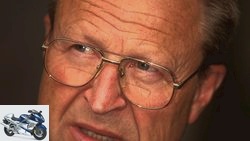
Sports & scene
What actually drives: Fritz W. Egli
20 questions to Fritz W. Egli
read more
Comfortable and touristy despite the soft suspension setup
Brute, but also not much stronger than a current S 1000 RR. Nevertheless: The feeling of acceleration is completely different. Gentle but decisive. I am surprised that the Egli-Kawasaki MRD 1 is so stable. Despite moped tires. Despite the soft suspension setup, which can be described with a clear conscience with attributes such as comfortable or touristy.
After another 50 kilometers, I even got used to the rather modest-looking front brake. And of being gawked at all the time. The Egli-Kawasaki MRD 1, the dream from the good old days, arouses desire without disappointing. Behind the huge disguise, life as a film flies past you. As if nothing is more important than what you are doing: driving. Any problems disappear in the rearview mirror. The MRD1 is still a drug, that much is clear. “And, had fun?”, Horst wants to know when the machine is back in his yard. How good that my parents taught me not to be jealous …
Brief portrait of Fritz W. Egli
Gargolov
Fritz W. Egli.
Fritz W. Egli himself says that he is a perfectionist, autodidact, pedant and racing driver. The now 77-year-old Swiss engine tuner and frame designer still loves extremes today: At the age of 72, he set a world record with his self-tuned 408-hp team at 336 km / h. The Egli-Kawasaki MRD 1 built by him on behalf of MOTORRAD was considered the world’s most powerful two-wheeler in 1979 and also set records. Fritz W. Egli is currently looking for a successor for his company who not only has technical and commercial skills, but also the necessary passion.
1 BILLION in MOTORRAD Revue 1979
Gargolov
The sensation in the MOTORRAD Revue 1979: The original version of the MRD1 had a Kawasaki Z 900 drive that had been drilled out and tuned to 1016 cubic meters and produced 140 HP on the rear wheel and 155 HP on the crankshaft.
The sensation in the MOTORRAD Revue 1979: The original version of the Egli-Kawasaki MRD 1 had a Kawasaki Z 900 drive that had been drilled out and tuned to 1016 cubic meters and produced 140 HP on the rear wheel and 155 HP on the crankshaft. In total, only five copies were made in Fritz W. Egli’s workshop. But he also sold some rolling chassis from the MRD1. The machine driven here is one of the five. It dates from 1982, has 1200 cc and 220 hp.
Related articles
-
Moto Guzzi V7 II Special in the driving report
fact 7 pictures fact 1/7 Moto Guzzi V7 II Special fact 2/7 The Moto Guzzi V7 II Special is not a marketing product of the rampant retro wave, … fact …
-
Energica Eva Ribelle in the driving report
Energica. 10 pictures Energica. 1/10 How does the new Energica Ego Ribelle fare on the first exit? Energica. 2/10 There are …
-
Horex VR6 Roadster in the driving report
Bilski 13 photos Bilski 1/13 Horex VR6 Roadster in the driving report. Bilski 2/13 Horex VR6 Roadster in the driving report. Bilski 3/13 Horex VR6…
-
Driving report LKM-Suzuki GSX-R 1000
Artist Driving report LKM-Suzuki GSX-R 1000 Enough is never enough Does it make sense to tune a Porsche 911 Turbo? Could we expect production motorcycles…
-
Driving report Yamaha SCR 950 (2018)
fact Driving report Yamaha SCR 950 (2018) The unknown being Don’t worry, there are now no endeavors on word games and comparisons with the always…
-
Driving report Yamaha XVS 650 Drag Star
Driving report, Yamaha XVS 650 Drag Star Yamaha XVS 650 Drag Star After the fat Royal Star, the little Drag Star appears in the chopper firmament. An XV…
-
Driving report Wunderlich R nineT Scrambler Six Days
20th photos 1/20 Driving report Wunderlich R nineT Scrambler Six Days. 2/20 Driving…
-
Driving report MSG-Triumph Rocket III
Gargolov 23 photos Gargolov 1/23 MSG-Triumph Rocket III in the driving report. Gargolov 2/23 MSG-Triumph Rocket III in the driving report. Gargolov 3/23…
-
Harley-Davidson Low Rider S in the driving report
markus-jahn.com 9 photos markus-jahn.com 1/9 The Harley-Davidson Low Rider S has a displacement of 1801 cm³… markus-jahn.com 2/9 … and 97 hp….
-
Bimota BB3 in the driving report
Bimota 35 photos Bimota 1/35 Bimota BB3 in the driving report. Bimota 2/35 Bimota BB3 in the driving report. Bimota 3/35 The handlebar of the Bimota BB3….